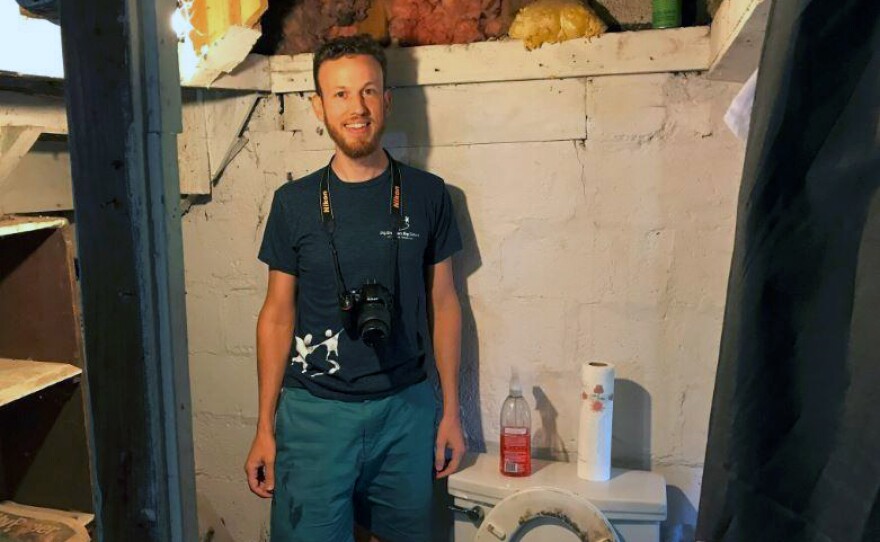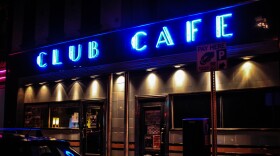Ted Zellers has knocked on doors from the West End to the North Side to Polish Hill and beyond, all to ask people if he can have a look in their basements.
“I’ve been surprised about how positive the reactions of people have been,” he said. “I was really worried when I started this that a lot of people would think I was a weirdo for wanting to do this.”

The Lawrenceville resident and amateur photographer is compiling photographs of those lone basement toilets. He said he’s hoping to one day share them in some kind of coffee table book, or eventually a gallery show.
“Everybody recognizes that, yes, toilets are a part of all of our lives,” he said.
It’s a part of life that a lot of people don’t really think a lot about. Basement toilets can come in handy, especially if there are multiple people living in an older house with only one finished bathroom. But Pittsburgh’s basement toilets often lack any accompanying sinks, showers or, more notably, walls.

“What I always liked about them was, they were obviously placed in unexpected spots,” said WQED host Rick Sebak. “So there’s no rhyme or reason as to where they’d be in the basement. Sometimes right in the middle, sometimes in a corner, which seems to make more sense.”
In 2007, Sebak hosted a special called "Underground Pittsburgh." It partly explored the region’s basements -- including Pittsburgh potties.
“I know that various people have accommodated it, you know, either put a curtain around it or, at my house, in the basement, somebody put cinder blocks, so it’s still open at the one end," he said. "It’s kind of a stall.”
But when and why Pittsburgh toilets originated is more difficult to pinpoint.
“People say that mill workers came home, they were super dirty, they didn’t want to dirty the house, so they went in through the basement, showered in the basement and did their bathing in the basement and then came upstairs where the house was clean,” said Stephen Cummings, a realtor with RE/MAX in Pittsburgh who primarily works in the East End.
Did you know about the Pittsburgh toilet? In basements of houses b4 WW2. Used by steel & mine workers b4 bathing. pic.twitter.com/YiaB6nX7fk
— ALCOSAN (@ALCOSAN) July 29, 2016
While that answer is accepted locally, there are few experts -- if any -- who can confirm that theory. Multiple local historians declined to verify the authenticity of the mill worker claim, since they didn’t specialize in basement, or toilet, history.
Cummings, who said he's sold or helped sell more than 600 houses in his eight years as a realtor, said Pittsburgh potties tend to show up in houses built between 1880 and 1910. Some showed up in houses in the ‘20s, less in the ‘30s and even fewer built in the ‘40s, he said, with them petering out after World War II.
But the 1880s were also a time when wealthier Pittsburghers might have had servants living in their houses. And with basement toilets in some of the city’s larger houses, Cummings has another idea.
“Some really large, older houses I’ve seen all over the city, if they’re large enough, they have signs of what was possibly even a kitchen in the basement, as well,” he said. “And I think that could show that they had servants living in the basement or using the basement as living quarters.”
But ultimately, the Pittsburgh potty evokes a sense of nostalgia for many locals. Sebak remembers them from his childhood.
“I can remember my grandmothers both had one in their basements and, you know, as a kid, it was kind of easier,” he said. “Just run down and use the toilet in the basement.”
That nostalgia and uniqueness is something Zellers is hoping to capture with his photo project.
“Culture comes big and small, public and private,” he said. “And the Pittsburgh toilet is...one that has almost no documentation associated with it, despite the fact that there is an incredible amount of variety and personalization in these toilets that people have put in over the years.
"I think that these are worth seeing. They’re worth sharing.”














